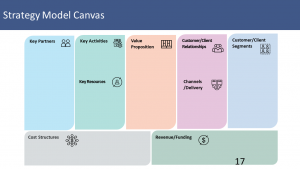2
The Business Model Canvas

https://mediahub.qut.edu.au/media/t/0_2998out9
How do you know if you have a good “model” for your strategy?
Use the Strategy Business Model Canvas!
Here we are using an extended name for the process. Originally it was called a Business Model Canvas. However, as usage has increased, it has become clear that there are many different uses and we have added Strategy for the title of this section. In fact, it can be a diagnostic canvas, an innovation canvas, a service canvas and others.
By the way, remember we often use the expression – The business of government – so this is as valuable for public sector works as it is for purely ‘for profit’ entities.
For this activity, we will settle with Canvas and you can specify its purpose for your workshop.

What is the Strategy Business Model Canvas?
The Business Model Canvas is considered for many a crucial activity used to create an overall business strategy, to evaluate or refine a current strategy, to launch a new enterprise, innovation or product. The Business Model Canvas encourages a particular focus on the organisation’s value proposition and the connection to customers and clients.
Why do we use the Strategy Business Model Canvas?
Having created a Business Model Canvas, the integrative, visual and ‘everything on a page’ model can encourage and support individuals and teams to assess the robustness and potential veracity of the proposed model. A typical question might be: How can we potentially improve and regenerate our current business model, or even generate new business model options?
How do we use the Strategy Business Model Canvas?
- The best way to start is to complete a list of the key customers for your organisation or division. Create a shortlist of the attributes and variables you would use to decide which are the key customers.
Remember that for many organisations, key customers can be INSIDE your organisation.
Add the list of key customers to the Canvas. Add a short description for some richness about this customer group and why they belong on the list.
2. Now start on the value proposition section. Start with an overall statement. Then you can add a short statement for each of the key customer groups.
Hints about value propositions
Remember that ‘We deliver high quality education’ is what you do, not what value you create and deliver. The value is in the minds of the recipients – value in use.
At GSB we believe that value propositions are in the frame of the customer, and they link the ‘give’ – what you perceive you offer and hope to deliver – with what the customer/end user perceives they receive. The ideal is that there is ‘fit’ between the ‘give’ and the ‘get’.
Emotion is key. This is why organisations use statements that relate to emotional elements of their brands and services. How will the customer ‘feel’: proud, successful, empowered, confident, safe?
Later we have added some additional processes you can use to identify and refine the various ‘get’ value outcomes for your customers. These include the three-component model of attitude formation, empathy mapping and customer jobs to be done.
3. It is up to you where you go next. You might want to work on the left of the canvas. What partners do you have to work with you to be able to deliver on your value propostion? Is there something or someone missing? What do you need to do to get this all aligned?
4. What are the essential activities that everyone in the value chain are nessecary for you to be able to create and deliver value?
5. What resources do you need? What do you have and won’t don’t you have?
6. Now is the perfect time to work on what channels and relationships do you have and should you have, to be able to deliver? Working on these two together makes sense as the nature of the relationship will help to determine the channels and delivery methods.
7. As you are working on your canvas you need to be flexible and to continually ‘sense check‘. The nature of the canvas is that if something is out of alignment, then the logic fails. The canvas makes us continuing look for alignment. Always be asking yourself and your teams those open questions about the alignment.
8. A crucial element of the canvas are cost structures and resources, and the revenue and funding components. Be creative about the cost and outcomes. Costs can include time, learning activities, opportunity costs as well as the financial costs of the overall model.
Outcomes of course include revenue, additional finding and other financial outcomes. They can also include customer loyalty, more business, brand equity, for example. You have latitude here to make it clear what are outcomes and benefits to your organisation.
Key Takeaways
The canvas is a great integrated process that forces you to consider alignment of many of the elements of delivering value for your customers, and ensuing that your organisation is able and willing to deliver, and will benefit from the efforts.
- Look for where you and your teams put their focus and emphasis. We watch where teams ‘start’. The messages are clear. Teams that start with the costs will likely have a very different mindset and inherent outcome to those that start exploring customers and delivery models. If in doubt, start with the value proposition and the customer segments.
- Other tools such as capability audits, the competitive landscape, and empathy mapping provide you with rich insights when you are working on your canvas.
